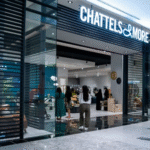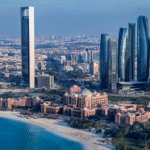Now Reading: Unlock Wealth: Dubai’s Tax-Free Model Boosts Island Prices
-
01
Unlock Wealth: Dubai’s Tax-Free Model Boosts Island Prices
Unlock Wealth: Dubai’s Tax-Free Model Boosts Island Prices

Table of Contents
Imagine owning a stunning villa on Palm Jumeirah, the Arabian Gulf sparkling outside your window, or a sleek apartment on Bluewaters Island, knowing your investment thrives in a tax-free haven that amplifies its value. In 2025, Dubai’s iconic island projects Palm Jumeirah, Palm Jebel Ali, Bluewaters Island, and Dubai Islands are global magnets for investors, driven by a tax-free model that eliminates personal income tax, capital gains tax, and annual property taxes.
The UAE’s dirham, pegged to the U.S. dollar, ensures currency stability, and residential purchases dodge 5% VAT, saving thousands. With 58% of buyers from countries like the UK, India, and Russia fueling 94,000 property transactions in the first half of 2025, these islands boast 4-6% rental yields and 8-12% price appreciation, outpacing London (2-4%) or New York (3-4%).
Properties over $545,000 qualify for a 10-year Golden Visa, while smaller units offer 2-year residency perks. This guide explores how Dubai’s tax-free model drives island real estate prices, spotlighting projects like Palm Jumeirah Ocean Villas, Palm Jebel Ali Coastal Lofts, Bluewaters Azure Residences, and Dubai Islands Horizon Villas, and offers strategies to capitalize on this dynamic market.
The Power of Dubai’s Tax-Free Model
Dubai’s tax-free environment is a game-changer for island real estate prices. By eliminating personal income tax, investors keep 100% of rental income, unlike in the U.S. (up to 37% tax) or UK (up to 45%). A $2 million property yielding 5% ($100,000 annually) delivers $55,000-$70,000 after taxes elsewhere, but in Dubai, every dirham stays with the investor. Zero capital gains tax saves $80,000-$112,000 on a $400,000 profit, compared to London or New York.
No annual property taxes save $20,000-$40,000 yearly on a $2 million property, unlike New York (1-2%) or London (council tax up to 2%). Residential purchases avoid 5% VAT ($100,000 on a $2 million home), and the 9% corporate tax spares individual landlords.
Free zone companies save $1,000-$30,000 annually, and small business relief waives corporate tax for revenues under $816,000 until December 31, 2026. These savings boost demand, driving prices upward as investors from 130+ countries flock to Dubai’s islands, where low vacancy rates (2-3%) and 25 million tourists fuel growth.
The tax-free model feels like a financial springboard, pushing island prices higher.
How Tax Savings Drive Demand and Prices
Dubai’s tax advantages increase buyer demand, tightening supply and elevating prices. The absence of taxes allows investors to reinvest full rental income and capital gains, attracting 58% non-resident buyers and sustaining 2-3% vacancy rates versus 7-10% globally. A $3 million Palm Jumeirah villa yielding $120,000-$180,000 tax-free annually draws high-net-worth buyers, reducing available inventory and pushing prices up 8-12% in 2025.
For example, a $4 million villa in 2024 could reach $4.48 million-$4.8 million by mid-2025, driven by tax-free profits of $480,000-$800,000. The 10-year Golden Visa for properties over $545,000 further fuels demand, as expats seek residency benefits.
Short-term rentals, leveraging 25 million tourists, boost yields by 10-20%, making islands like Bluewaters and Dubai Islands particularly attractive. This demand-supply dynamic creates a cycle where tax savings amplify price growth.
The tax-free edge feels like a magnet, pulling global wealth to Dubai’s islands.
Palm Jumeirah: Tax-Free Luxury Fuels Price Surge
Palm Jumeirah, Dubai’s iconic palm-shaped island, sees 2025 prices for villas ranging from $3 million to $10 million and apartments from $816,750 to $3.27 million, with 8-12% appreciation. The tax-free model drives demand, with a 2% vacancy rate and 4-6% rental yields. A $4 million villa yields $160,000-$240,000 tax-free annually, versus $88,000-$144,000 elsewhere, saving $72,000-$96,000. Selling it for $5 million yields a $1 million tax-free profit, saving $200,000-$280,000 in capital gains tax. No property taxes save $40,000-$80,000 yearly, and VAT exemption saves $200,000.
Palm Jumeirah Ocean Villas
Palm Jumeirah Ocean Villas by Nakheel, set for completion in Q2 2025, offer 4-6 bedroom villas ($3 million-$6 million) with 4,000-6,000 square feet, private beaches, and smart systems. Initial costs include a 4% Dubai Land Department (DLD) fee ($120,000-$240,000), 2% broker fee ($60,000-$120,000), and a 20/50/30 payment plan. Maintenance fees are $15,000-$25,000, with a 5% municipality fee ($8,000-$12,000).
A Qualified Free Zone Person (QFZP) saves $40,800-$61,200 on $408,000-$612,000 in rental income. U.S. investors deduct depreciation ($72,727-$109,091) and management fees ($7,455-$14,545), saving up to $36,364. Golden Visa eligibility applies. Short-term rentals boost yields by 10-20% with Department of Tourism and Commerce Marketing (DTCM) registration ($408-$816).
The beachfront luxury feels like a tax-free, high-return paradise.
Palm Jebel Ali: Tax-Free Value Boosts Emerging Prices
Palm Jebel Ali, relaunched in 2023, offers villas at $2.72 million-$5.44 million and apartments at $680,625-$2.04 million, with 8-12% price growth. Its tax-free model and 3% vacancy rate attract younger expats, pushing prices 20-30% lower than Palm Jumeirah but with strong upside.
A $2 million apartment yields $80,000-$120,000 tax-free annually, versus $44,000-$72,000 elsewhere, saving $36,000-$48,000. Selling it for $2.5 million yields a $500,000 tax-free profit, saving $100,000-$140,000. No property taxes save $20,000-$40,000 yearly, and VAT exemption saves $100,000.
Palm Jebel Ali Coastal Lofts

Palm Jebel Ali Coastal Lofts by Nakheel, set for completion in Q3 2025, offer 2-4 bedroom apartments ($1.36 million-$3.27 million) with 1,500-3,500 square feet and sea views. Initial costs include a 4% DLD fee ($54,400-$130,800), 2% broker fee ($27,200-$65,400), and a 50/50 payment plan. Maintenance fees are $8,000-$15,000, with a 5% municipality fee ($4,000-$6,000). A QFZP saves $20,400-$30,600 on $204,000-$306,000 in rental income. U.S. investors deduct depreciation ($36,364-$72,727) and management fees ($3,727-$8,182), saving up to $24,545. Golden Visa eligibility applies. Short-term rentals boost yields by 10-20%.
The coastal vibe feels like a vibrant, tax-free growth hub.
Bluewaters Island: Tax-Free Prestige Drives Price Growth
Bluewaters Island, home to Ain Dubai, sees 2025 prices for villas at $3.27 million-$6.54 million and apartments at $1.36 million-$3.27 million, with 8-12% appreciation. Its 2% vacancy rate and 4-6% yields benefit from tax-free savings. A $2 million apartment yields $80,000-$120,000 tax-free, versus $44,000-$72,000 elsewhere, saving $36,000-$48,000. Selling it for $2.5 million yields a $500,000 tax-free profit, saving $100,000-$140,000. No property taxes save $20,000-$40,000 yearly, and VAT exemption saves $100,000.
Bluewaters Azure Residences
Bluewaters Azure Residences by Meraas, set for completion in Q1 2026, offer 2-4 bedroom apartments ($1.36 million-$3.27 million) with 1,500-3,500 square feet and wellness-focused amenities. Initial costs include a 4% DLD fee ($54,400-$130,800), 2% broker fee ($27,200-$65,400), and a 50/50 payment plan. Maintenance fees are $8,000-$15,000, with a 5% municipality fee ($4,000-$6,000). A QFZP saves $20,400-$30,600 on $204,000-$306,000 in rental income. U.S. investors deduct depreciation and management fees, saving up to $24,545. Golden Visa eligibility applies. Short-term rentals boost yields by 10-20%.
The coastal prestige feels like a refreshing, tax-free haven.
Dubai Islands: Tax-Free Potential Fuels Price Uptick
Dubai Islands, an emerging archipelago, offer villas at $2.72 million-$5.44 million and apartments at $816,750-$2.04 million, with 8-12% price growth. Its 3% vacancy rate and tax-free model attract investors, with prices rising due to new infrastructure. A $1.2 million apartment yields $48,000-$72,000 tax-free, versus $26,400-$43,200 elsewhere, saving $21,600-$28,800. Selling it for $1.5 million yields a $300,000 tax-free profit, saving $60,000-$84,000. No property taxes save $12,000-$24,000 yearly, and VAT exemption saves $60,000.
Dubai Islands Horizon Villas
Dubai Islands Horizon Villas by a leading developer, set for completion in Q2 2026, offer 4-6 bedroom villas ($2.72 million-$5.44 million) with 4,000-6,000 square feet and private beaches. Initial costs include a 4% DLD fee ($108,900-$217,800), 2% broker fee ($54,450-$108,900), and a 20/50/30 payment plan. Maintenance fees are $12,000-$20,000, with a 5% municipality fee ($6,000-$9,000). A QFZP saves $30,600-$45,900 on $306,000-$459,000 in rental income. U.S. investors deduct depreciation and management fees, saving up to $36,364. Golden Visa eligibility applies. Short-term rentals boost yields by 10-20%.
The emerging waterfront feels like a vibrant, tax-free sanctuary.
Tax Strategies to Maximize Returns
To leverage the tax-free model, use these strategies. First, hold properties as an individual to avoid the 9% corporate tax, keeping 100% of rental income. Second, set up a QFZP free zone company to save $12,240-$61,200 annually on $122,400-$612,000 in rental income, with setup costs of $2,000-$5,000. Third, recover 5% VAT ($20,000-$80,000) on off-plan purchases via Federal Tax Authority (FTA) registration ($500-$1,000).
Fourth, leverage small business relief for revenues under $816,000 until 2026. Fifth, U.S. investors should deduct depreciation ($36,364-$109,091), maintenance ($8,000-$25,000), and mortgage interest on Schedule E, saving up to $36,364. Sixth, non-U.S. investors can use double taxation treaties with 130+ countries to avoid taxes like the UK’s 20-28% capital gains tax. Hire a property manager ($8,000-$25,000 annually) and consult tax professionals to ensure compliance.
These strategies feel like a roadmap to amplify your island investment.
Costs Impacting Prices
Buying a $2 million property incurs a 4% DLD fee ($80,000), 2% broker fee ($40,000), and a 10% deposit ($200,000). Flexible payment plans (50/50 or 20/50/30) spread costs, with 50-70% paid during construction. Annual maintenance fees range from $8,000-$25,000, and landlords pay a 5% municipality fee ($4,000-$12,000). Short-term rentals require DTCM registration ($408-$816), while long-term leases need Ejari registration ($54-$136). Off-plan purchases may incur 5% VAT ($20,000-$80,000), recoverable via FTA registration. These costs, offset by tax savings, contribute to price stability and investor confidence.
The costs feel like a small price for tax-free, high-return potential.
Navigating Risks in 2025
A projected oversupply of 41,000 units may slow price growth. Mitigate by choosing trusted developers like Nakheel or Meraas, verifying escrow compliance under the 2025 Oqood system, and targeting low-vacancy projects (2-3%). Ensure QFZP and VAT compliance to avoid fines up to $136,125. Short-term rentals in Bluewaters boost yields, while long-term leases in Palm Jumeirah ensure stability. Proximity to Dubai Marina and global demand drive value. Regular market analysis keeps you ahead.
Why Dubai’s Islands Are Top Picks
Dubai’s tax-free model fuels price growth in Palm Jumeirah Ocean Villas, Palm Jebel Ali Coastal Lofts, Bluewaters Azure Residences, and Dubai Islands Horizon Villas by attracting global buyers and sustaining low vacancy rates. With 4-6% yields, 8-12% price appreciation, and tax savings of $12,000-$280,000 annually, these 2025 projects offer a prestigious, high-return lifestyle. The tax-free environment amplifies demand, making Dubai’s islands a vibrant, wealth-building haven for investors seeking luxury and profitability.
read more: Palm Islands Properties: 2025 Pricing Trends and Tax Strategies






















